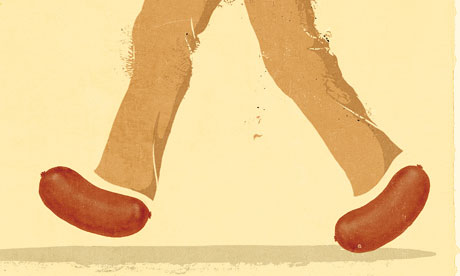
According to research published this spring, people make healthier menu choices when calories are listed beside each item – but they make even better choices when they're told how far they'd have to walk to burn off the calories consumed. This makes sense: for most of us, a calorie is a nebulous, hard-to-visualise thing, while a listing such as "burger: 2.6 miles" brings things sharply into focus. Somebody, it occurs to me, ought to design an app along these lines, for eating out: it would ask me what kind of food I'd like, then direct me only to those restaurants sufficiently far away that I'd neutralise the effect of the meal by walking there. In the mood for salad? There's a place on the corner. Hungry for sausages, cheesy chips and a large slice of cake? Time to dig out the hiking boots.
This same basic strategy – expressing the impact of our choices in quantities that really matter to us, rather than in quantities that don't – underlies The Norm Chronicles, a recent book by Michael Blastland and David Spiegelhalter that translates a plethora of everyday hazards into what they call "microlives". Really, this is just a fancy term for "half an hour of life"; a burger, they explain, knocks one microlife off the average adult's expectancy, as do two cigarettes. It's a clever way of adding immediacy to "chronic risks". Those risks, unlike skydiving or playing chicken on the railway tracks, that accumulate so gradually they're easy to ignore. Thinking in microlives also makes it evident that unhealthy, life-shortening choices can be balanced by life-extending ones: the first 20 minutes of exercise each day, for example, adds two. (Further minutes of exercise, sadly, are less beneficial.)
Perhaps the best example of this way of thinking is from the neglected 1992 book Your Money Or Your Life, by Joe Dominguez and Vicki Robin. They recommend thinking about your spending in terms of the hours you must work to generate the cash. To do this, you calculate your "real hourly wage"; but that doesn't just mean dividing your monthly salary by hours worked. Rather, you must add all the other hours you invest in your job (commuting time, say, or time spent vegging out because you're exhausted), while subtracting all the money you spend on it (costs such as childcare, smart clothes and escapist treats you wouldn't need if you didn't work). The smallness of the resulting figure will probably alarm you. But whatever the number, whenever you spend that amount on some purchase, you're effectively spending an hour of what Dominguez and Robin call "life energy". Which might make you think twice about those new shoes. More radically, it might motivate you to "downshift", since some lower-paid jobs may confer a higher true hourly wage.
All these techniques involve value judgments, of course: if you love your job to bits, you might not mind a lifestyle that commits you to working ever harder. Likewise, when it comes to microlives, longevity isn't everything: perhaps you'd rather enjoy more burgers, exercise less and (probably) die younger. "No pleasure," Kingsley Amis said, "is worth giving up for the sake of two more years in a geriatric home at Weston-super-Mare." You may agree. But at least once you're thinking in terms of vivid quantities – microlives and life energy, rather than calories and cash – you'll have the information you need to make a conscious choice.
oliver.burkeman@theguardian.com
Follow Oliver on Twitter.

